Military Road Rising Main Replacement Scheme (2016)
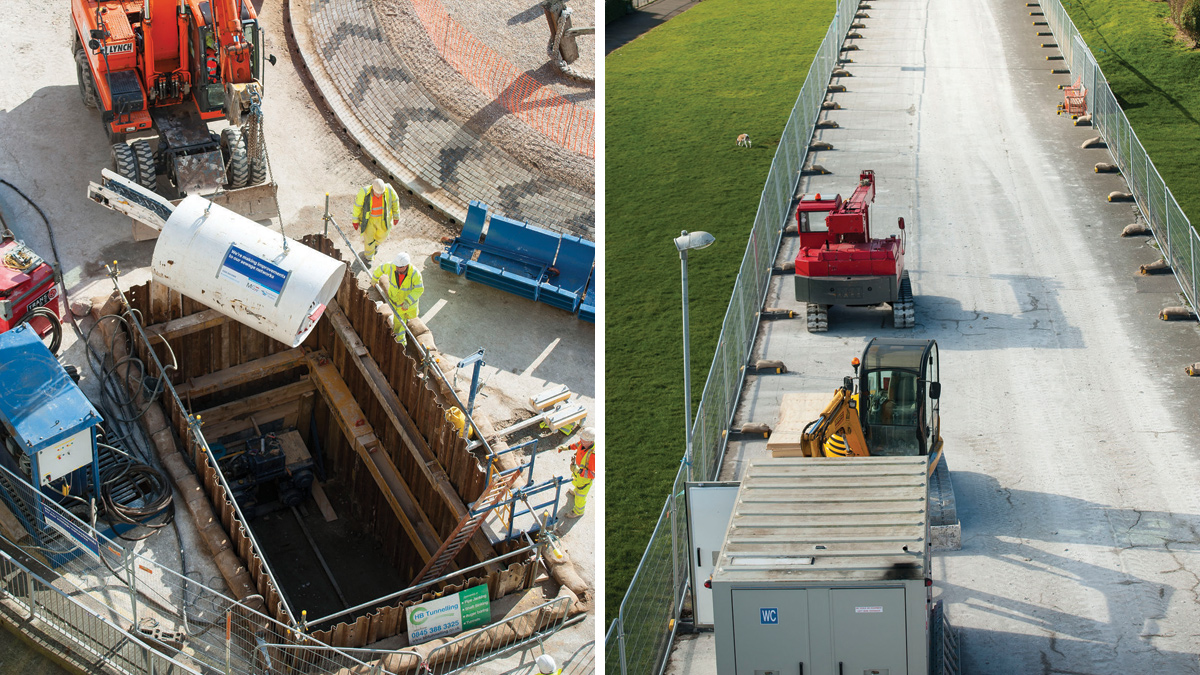
(left) Tunnelling machine being lowered into the drive pit, this tunnel links Military Road Pumping Station to the new rising main and (right) An alternative access route was used to minimise the affect on community events held throughout the year on Government Acre - Courtesy of Southern Water
Ramsgate is a seaside town on the North East Kent coast; its coastline and harbour attracts thousands of tourists each year. The wastewater from the town is pumped to Weatherlees Hill Wastewater Treatment Works, situated inland over 6km away. Over a 15-year period the pipeline had suffered a number of bursts and needed replacing as part of Southern Water’s commitment to removing wastewater effectively and to maintaining excellent bathing water quality.
Location
Ramsgate is situated within the wider district of Thanet. In the 19th century, it was one of the great English seaside towns with a population of 40,000. The main attraction of the area is its coastline, with the region benefiting from a high quality environment encompassing seaside towns, rural landscapes, high quality beaches and rare habitats.
The replacement of the wastewater rising main was identified as part of Southern Water’s commitment to removing wastewater effectively and to maintaining excellent bathing water quality. Southern Water’s Drainage Strategy for North East Kent focuses on a strategic approach to drainage planning. The aim is to ensure reliable and sustainable wastewater services for the region, whilst accommodating population growth, new development, climate change and higher environmental quality standards.
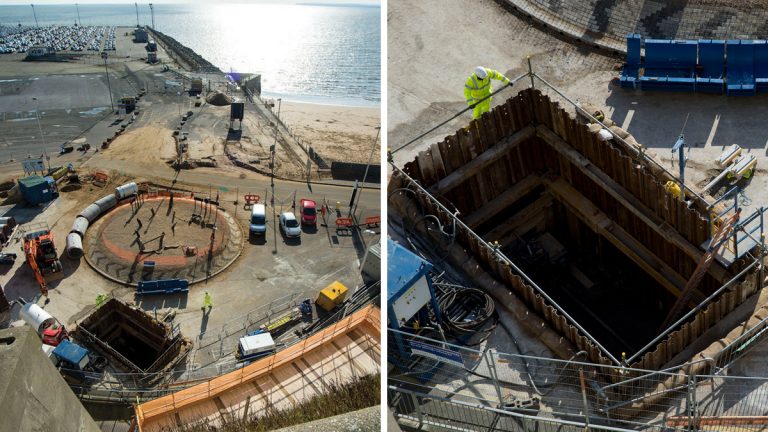
(left) Military Road drive pit with traffic management ensuring access to the Port and (right) access point to the new tunnel that links to the shaft bringing wastewater down from the top of the cliff – Courtesy of Southern Water
Drivers
Wastewater is pumped 6.5km from Military Road Wastewater Pumping Station (WwPS), serving the Ramsgate catchment, to Weatherlees Hill Wastewater Treatment Works, situated on the coastal strip at Pegwell Bay. Over a 15-year period the pipeline had suffered a number of bursts.
In 2013, a feasibility study was undertaken, from which four options were presented. The preferred option was to follow the existing route, modified to accommodate construction and environmental challenges, whilst keeping the existing pipeline operational throughout construction.
In 2014, the decision was made to replace the majority of the remaining rising main, shortly after two smaller sections were replaced due to the loss of structural integrity of the 600mm unlined ductile iron (DI) pipe. The chosen pipe material was cement lined DI shown to be the most cost effective and easiest to install in the urban environment. Installing 6m lengths of pipe made permanent reinstatement faster helping to minimise the amount of road space required and associated traffic management.
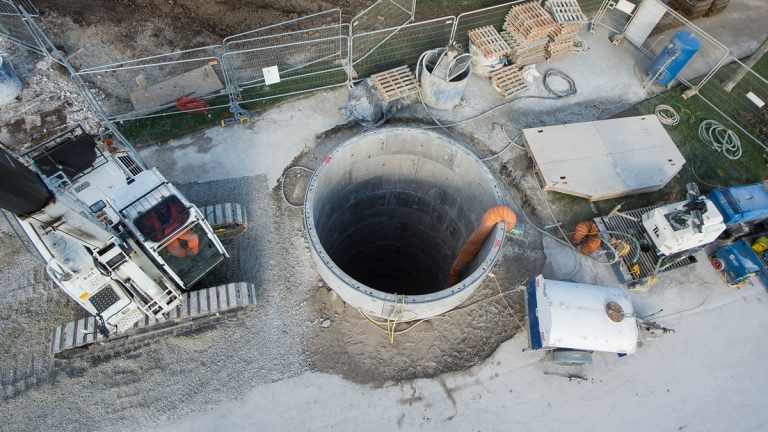
4.50m diameter, 25m deep shaft constructed on the top of the cliff – Courtesy of Southern Water
The design
The main design and construction challenge presented itself in a half kilometre stretch of reinforced concrete carriageway, forming the reconstructed A299 access road. The existing pipeline was located deep under this road, serving the commercial port. Rebuilt in 2000, the road carries freight traffic to and from the wider trunk road network via a tunnel through the cliffs, avoiding a route through the town centre and its narrow streets.
The solution was to bypass this section completely by raising the 600 DI pipe through a 4.5m diameter shaft up to a depth of 25.0m, using 1,000mm x 200mm smooth bore precast shaft lining segments. The shaft was sunk through the chalk cliff within a SSSI designated area and adjacent to the Victorian lift structure, a local landmark.
The shaft was sunk 20m back from the cliff edge to reduce any potential impact on habitat with the base of the shaft connected to the existing main by 35m of pipe jacking using precast concrete pipes 1,200mm OD. The new main at the top of the shaft then connected the cliff top to the section of existing rising main via the Royal Esplanade after winding its way through the residential western suburbs of Ramsgate.
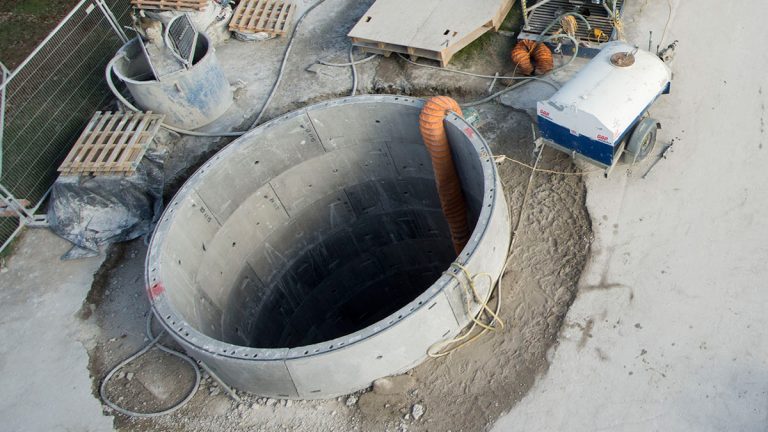
Sacrificial top ring used as edge protection during construction – Courtesy of Southern Water
Under normal dry weather operating conditions, Military Rd WwPS passes forward around 100l/s (8.64Mld), which was consistent with the contributing population and normal infiltration. The maximum output from the DWF pumps is 435l/s, or 4.35* DWF, with a maximum operating pressure of 4bar (40m), and surge pressures of 9bar.
Surge analysis showed that the pipeline operated in two separate sections, splitting the total length of the pipeline roughly in half with the pumped rising main running between Military Road WwPS and the highest point on the pipeline, pressured by the pumps at Military Road WwPS.
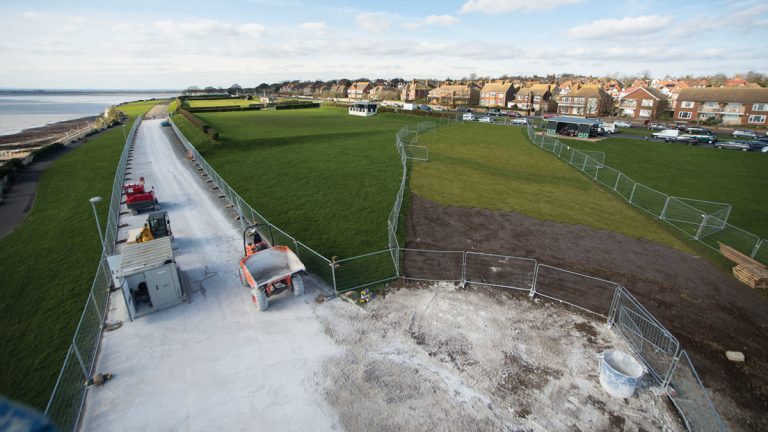
Re-turfing of Government Acre following the completion of the work in this area – Courtesy of Southern Water
The remaining section, between the highest point and the inlet at Weatherlees Hill WwTW, is a gravity system. In order to regulate flow of the part full and inverted siphon sections of the gravity section, a 9m3 surge vessel was installed at the WwPS, with an initial air volume of 5m3.
This is designed to reduce sub-atmospheric pressure build up and protect the main following instantaneous shut downs brought about by unplanned events. In addition, 6 (No.) DN100 air valves, suitable for sewage application and surge alleviation were installed, located at high points along the main.
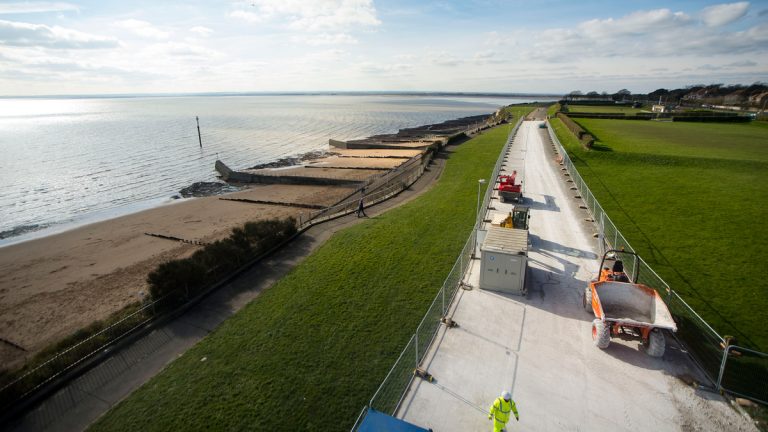
Aerial view of access road and cliff edge along the coastline – Courtesy of Southern Water
The stakeholder challenges
In addition to the design and construction challenges of constructing the new rising main within a deep shaft behind the cliff face, an even greater challenge presented itself in the form of stakeholder engagement surrounding the high profile location of the works within the town centre.
The Victorian Upper Promenade, owned by Thanet District Council, forms a scenic back drop to the old Ramsgate Harbour, which was the main assembly point for the build-up of small craft needed for Operation Dynamo, the evacuation of the British Expeditionary Force from Dunkirk. Much of the seafront trade is focused around The Boating Lake, Bandstand, Bowling Greens and ‘Government Acre’ where events take place almost every weekend, ranging from concerts and classic car events to road running races.
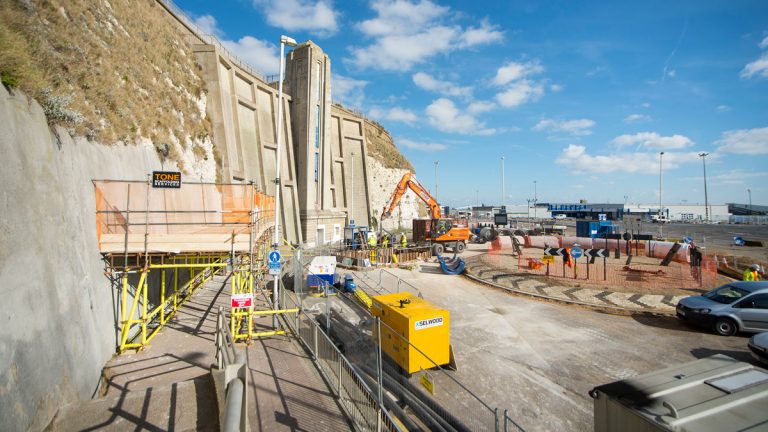
Scaffold deck constructed over footway to protect pedestrians from falling debris from cliff face – Courtesy of Southern Water
Southern Water, working in partnership with Thanet District Council, prioritised summer traders in the local area with a view to minimise any disruption during the key summer season. A stakeholder group was set up early in the project, prioritising traders and residents living on the Upper Promenade. Design changes were made, involving the relocation of the shaft to maintain the maximum amount of space for users of Government Acre and to minimise the visual impact.
In addition, the construction programme was revised to ensure that it would not impact the area during the busy, summer tourist season. Local customers and stakeholders were kept informed through regular drop-in sessions and update leaflets and letters.
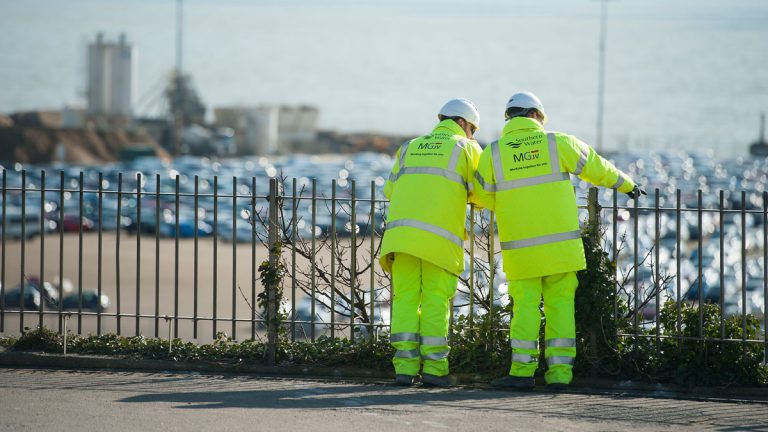
The project was completed by Southern Water’s delivery partner for networks improvements, MGjv (a joint venture between Morrison Utility Services and Galliford Try) – Courtesy of Southern Water
Status and progress
The new rising main was connected on the 14 June 2016, completing phase one of the project and removing any potential for pollution to bathing water through bypassing the beachfront area.
Phase two is currently underway to install the final 1,200m of rising main through agricultural land on the western fringes of the town, with a view to completing the project by Christmas 2016.



